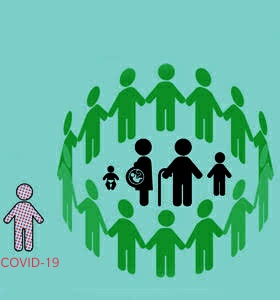Age-adjusted risk stratification for COVID-19

In a certain variety of thyroid cancer, the common well-differentiated type, advancing age of the patient bears major significance on prognosis and mortality. (1) Age-adjusted risk stratification has become standard practice for the management of these patients following surgery.
Thyroid cancer patients below the age of 55-60 years are stratified as low risk category since they have a 95-98 percent long-term survivorship – a permanent cure – following adequate surgery. Attempts to improve further upon survival figures in this group would involve subjecting all of the patients to rigorous follow-up, additional investigations and further treatment. Even then, the ultimate benefit would be marginal considering the already existing high survival statistics and on the contrary, it could negatively affect the lifestyle and morale of these patients, majority of who are young, fit and otherwise healthy. On the other hand in those over 55-60 years of age thyroid cancer behaves more aggressively and cure rates fall to around 80%. For these reasons, efforts in reducing overall mortality from thyroid cancer are directed towards this older high-risk group of individuals by aggressive post-surgical treatment, regular screening and early identification of relapses. This strategy has resulted in improvement of the overall survival statistics in thyroid cancer across all age-groups without putting every patient through the same rigorous screening and treatment.
In COVID-19 too available statistics from across the world has shown that mortality in healthy individuals below 50 years of age is low – in the range of 0.08-0.4% of those infected. (2) But in those above 70 years mortality could be as high as 20% of infected individuals especially in the presence of associated co-morbidities such as diabetes, heart disease or cancer. In countries such as the U.S. (16% of the population is over 70 years) and Italy (22%), despite the availability of more advanced health care, mortality has been high due to an aging population.
We are fortunate that India’s young far out-number its older population – eighty-five percent are below 50 years of age and only 3.2% above 70 years. (3)
A total lock down for a prolonged period of time causes the biggest disruption in lives of younger people, who also are at the most productive years of their lives. This in turn has major repercussions on the nation’s economy. A lock down will slowdown the spread of the virus and save lives, but if continued indefinitely, it will also destroy the country’s economy and ultimately the country itself.
As the government is grappling with various alternatives to come out of the present impasse, a partial lock down with age-adjusted risk stratification of the population could save lives and the economy as well.
People are divided into 3 groups:
- Low-risk group – Healthy individuals below 50 years
- Intermediate risk group – Healthy individuals between 50-70 years
- High-risk group – Those above 70 years and everyone with serious associated illnesses (cancer, TB, uncontrolled diabetes, heart conditions etc)
The low risk group continue to work (or study) practicing basic precautions (regular hand-washing and wearing masks in public areas), the high risk group is isolated and protected from the rest of the population and the intermediate risk group (where mortality from the virus ranges between 0.4-3.6%) is given the option of staying away and avoiding exposing themselves or working with strict adherence to personal protection measures and social-distancing norms.
With current data resources available with the government, identifying these age groups may not be such a big task, especially if private digital platforms are also roped in. Implementation could stretch government resources but with the adoption of this strategy lives may be saved without the economy going bust. Gradually, in a phased manner, as more and more people (mostly the young) get exposed ; herd immunity which develops will help protect the rest.
References:
- https://bmccancer.biomedcentral.com/articles/10.1186/s12885-018-4181-4
- https://www.vox.com/2020/3/23/21190033/coronavirus-covid-19-deaths-by-age
- https://en.wikipedia.org/wiki/Demographics_of_India#Comparative_demographics
Also read COVID-19 – Part 1 Click Here
CLICK HERE TO RECEIVE FUTURE BLOGS

3 comments
Pragati Nayak
April 6, 2020 at 6:11 am
What an idea, Sirji! Hope it works if implemented.
Umanath Nayak
April 6, 2020 at 6:20 am
Wish there could have have been an easier way out….!
Purnima
April 8, 2020 at 6:32 am
Very well written and makes tremendous sense. I am sure it can be implemented. Sir consider sending this proposal to the government